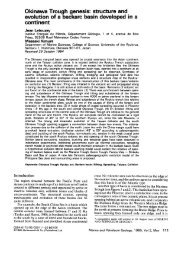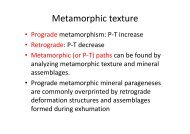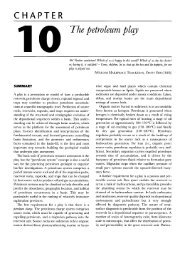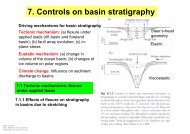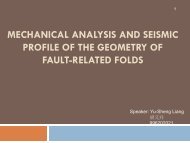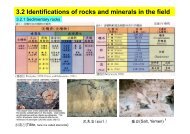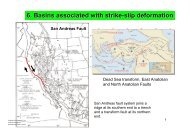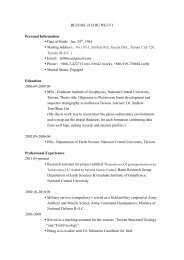Paleosols in clastic sedimentary rocks: their geologic applications
Paleosols in clastic sedimentary rocks: their geologic applications
Paleosols in clastic sedimentary rocks: their geologic applications
- No tags were found...
You also want an ePaper? Increase the reach of your titles
YUMPU automatically turns print PDFs into web optimized ePapers that Google loves.
62( )M.J. KrausrEarth-Science ReÕiews 47 1999 41–70Ž Cerl<strong>in</strong>g, 1991, 1992 .. Cerl<strong>in</strong>g Ž 1991.and othersŽ e.g., Driese and Mora, 1993.have shown that levelsof CO2<strong>in</strong> the atmosphere have varied over time andhave differed significantly from the modern levelsunder which the empirical curve was constructedŽ see Section 6 .. A second potential problem is thatMAP can be underestimated if the upper part of apaleosol has been truncated. Retallack Ž 1994.hassuggested ways to avoid these two problems, and thereader is referred to his discussion.A more contentious problem is the effects ofsediment compaction, especially if the <strong>rocks</strong> haveundergone significant burial. Retallack Ž 1994.hastended to calculate depth to the carbonate horizonafter decompact<strong>in</strong>g the strata us<strong>in</strong>g the compactioncurves of Baldw<strong>in</strong> and Butler Ž 1985 .. Yet, severalstudies suggest that these curves are not appropriatefor paleosols and, <strong>in</strong> fact, that many paleosols arelittle affected by compaction. In an <strong>in</strong>novative study,Caudill et al. Ž 1996.used vertical micro-cracks <strong>in</strong>Paleozoic Vertisols to show that the paleosols underwentno more than 10% compaction despite thedepth of burial. Caudill et al. concluded that, becauseVertisols have <strong>in</strong>itial bulk densities that are quitehigh, they undergo little compaction with burial. In<strong>their</strong> case, they calculated 650 mm of precipitationon the basis of depth to the carbonate horizon <strong>in</strong> theVertisols, which is comparable to the precipitationunder which modern Vertisols form. Evidence fromboth modern and ancient floodpla<strong>in</strong> deposits also<strong>in</strong>dicates that, because paleosols require surface exposure,they underwent significant dewater<strong>in</strong>g andcompaction prior to burial Ž Nadon and Issler, 1997 ..These studies suggest that depth to the calcic horizoncan be used directly to estimate MAP as long asproblems with truncation and paleoatmospheric CO 2can be reconciled.5.3. Isotopic analysisFor a thorough discussion of the factors controll<strong>in</strong>gthe isotopic composition of soil m<strong>in</strong>erals and theproblems encountered <strong>in</strong> <strong>in</strong>terpret<strong>in</strong>g isotopic compositions,the reader is referred to Cerl<strong>in</strong>g and Quade18Ž 1993 .. In brief, the d O value of soil carbonatedepends on the isotopic composition of the meteoricwaters from which it precipitated. The isotopic compositionof the meteoric waters is, <strong>in</strong> turn, <strong>in</strong>fluencedby the mean annual temperature Ž MAT. ŽCerl<strong>in</strong>g,1984; Cerl<strong>in</strong>g and Quade, 1993 .. Furthermore, thecarbon isotopic composition of modern soil carbonatestends to be higher <strong>in</strong> warmer areas because thek<strong>in</strong>d of vegetation Ž C vs. C plants.3 4 is temperaturedependent. C 3 plants, which <strong>in</strong>clude most trees,shrubs, and cool-season grasses, produce soil carbonated 13 C values around y27% whereas C 4 plants,which <strong>in</strong>clude most of the summer grasses andsedges, produce a value around y12%. On the basisof studies that show a major change from C 3 to C 4vegetation between 8 and 7 Ma ŽCerl<strong>in</strong>g, 1992;Cerl<strong>in</strong>g et al., 1993; Quade et al., 1994, 1995; Latorreet al., 1997 ., most paleoclimatic <strong>in</strong>terpretationsof pre-Miocene paleosols assume that the vegetationconsisted entirely of C 3 plants. Because of theserelationships between isotopic composition and temperature,paleosol carbonates have been analyzed toreconstruct paleoclimates Že.g., Mack et al., 1991;Koch et al., 1995 .. Other soil m<strong>in</strong>erals, particularlyclay m<strong>in</strong>erals, are also potentially useful Že.g., Sternet al., 1997 ..Reconstruct<strong>in</strong>g paleoclimates us<strong>in</strong>g the isotopiccomposition of paleosol m<strong>in</strong>erals suffers from severalproblems. First is climatic overpr<strong>in</strong>t<strong>in</strong>g, whichcan occur if sediment accumulates very slowly andthe pedogenic carbonate precipitates under more thanone climatic regime Ž Cerl<strong>in</strong>g, 1984 .. In those circumstances,the carbonate will conta<strong>in</strong> an isotopicmix. Second, the oxygen isotopic composition of soilm<strong>in</strong>erals is more prone to diagenetic modificationthan is the carbon isotope composition. Studies ofLate Paleozoic pedogenic carbonates by Driese andMora Ž 1993.and Eocene carbonates by Cerl<strong>in</strong>gŽ 1991.showed little if any diagenetic alteration ofthe carbon isotopes; however, the d 18 O <strong>in</strong> both exampleswas depleted as a result of recrystallization.To understand more thoroughly the effects of diagenesison oxygen isotopes, Mora et al. Ž 1998.analyzedthe isotopic compositions of pedogenic calciteand illite <strong>in</strong> three vertic paleosols that underwentdifferent burial depths and burial temperatures. Theirresults clearly demonstrate that the oxygen isotopes<strong>in</strong> this example were affected by burial diagenesisand are not appropriate for paleoenvironmental andpaleoclimatic <strong>in</strong>terpretations.Cognizant of the limitations to oxygen isotopes,Mack et al. Ž 1991.used the isotopic composition of



